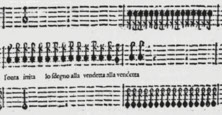The sixteenth notes 'in the combat'
(V1bT2)

Ex. 1 Dramatic sixteenth note passages in Telemann’s Don Quichotte, ‘Son attaque des moulins à vent’, bb. 5-6, (17??).
There are two types of sixteenth-note passages in Windmills. One type can be recognized as a 'battle figure', reminiscent of the concitato style from the early seventeenth century. Monteverdi describes this style in the preface to the Eighth Madrigal Book. He ascribes to the repeated tremolo-like notes (the reiterated pulse of Greek pyrrhic metre) a martial agitated affect (Palisca, 2006).


Ex. 2 'Concitato' style, where the reiterations of the sixteenth notes creates the excitement of the battle, is claimed by Monteverdi as his own invention in his Il Combattimento (1638). Telemann uses a similar effect in ‘Son attaque des moulins à vent’, bb. 5-6, (17??).
Applying the sonic features to represent the drama of a battlefield, a Soundist will enhance dynamics and accentuation. The repeated 'concitato' notes (f-sharps in Ex. 3) will dynamically match the descending top-notes line (b-a-g). We can either accent the down beat followed by a diminuendo, or do the opposite, starting the bar softer and making a crescendo towards the accent in the middle of the bar. Because of the shape of the bass and middle voices, the latter alternative works better here.

Ex. 3 & Aud. 1 'Concitato' expressed through dynamics.
The bar structure has now got a clear sonic shape, but it still lacks the excitement of the battle. What would a Gesturist do? Instead of a continuous dynamic line, moving towards the middle of the bar, I experiment with building the phrase with small 'fighting' patterns. The accents on the descending top notes – the clashes of the swords – bounce towards the middle of the bar. The repeated sixteenth notes in between the accents do not adopt the same dynamic shape as the four accents on the structural level, but simply represent a noise between the clashing of the swords. This reduces the amount of structural events in the bar, so that the phrase consists of three bouncing accented quarter notes, each with a 'noise' reverberation.

Ex. 4 & Aud. 2 'Concitato' style realised as gesture.
The other type of sixteenth note passage comprises an upward running pattern over two bars (Ex. 5).

Ex. 5 The sixteenth note upward runs in Telemann’s Don Quichotte, ‘Son attaque des moulins à vent’, bb. 2-3, (17??).
The sixteenth note pattern seem to strive upwards against a resisting force, as if depicting the intensifying battle. The dynamic shape follows the topographic shapes in the notation. A Soundist may use a long continuous crescendo:

Ex. 6 The sixteenth note runs shaped through dynamics.
Vid. 1 The sixteenth note runs shaped through dynamics.
As in the concitato style above, the sixteenth note running pattern will also need more differentiated dynamic shapes in order to express the excitement and irregular timing of the sword action. A Gesturist will break the continuous two-bar sequence into smaller individual units, pushing through the resistance step by step. As I instructed the players of my student orchestra, reaching for the top of the phrase should feel nervous; it is, after all, quite dangerous to engage in battle with a sword in hand. The increase in volume in the upward climb happens in several waves, with each wave bigger than the previous one (Ex. 7).

Ex. 7 & Vid. 2 The sixteenth note upward running pattern as a bodily gesture.
Although the instrumental effect of sword fighting might not have been as strikingly new in Telemann’s time as in 1638, when Monteverdi employed it in his Combattimento, the sensation in body movements in enacting the sword fighting is similar. For a comparison, in the following video example (Vid. 3), the string ensemble accompanies the narrator in a description of a battle between Tancredi e Clorinda (Monteverdi, 1638), complementing the narrator’s dramatic declamation with sounds and body movements drawn from the imagery of a battle.
Vid. 3 This excerpt demonstrates the concitato style invented by Claudio Monteverdi in his Combattimento (1638).
In my Gesturist experiments I aim to achieve a multi-layered kinaesthetic assimilation of sword fighting action, engaging the playing body in metaphorical fighting movements that are jerky, irregular and impulsive. In such a dynamic kinaesthetic context, the bowing action produces a sounding result that is permeated with an enhanced physicality reminiscent of sword fighting.